2016 MITSUBISHI OUTLANDER Back seats
[x] Cancel search: Back seatsPage 37 of 464
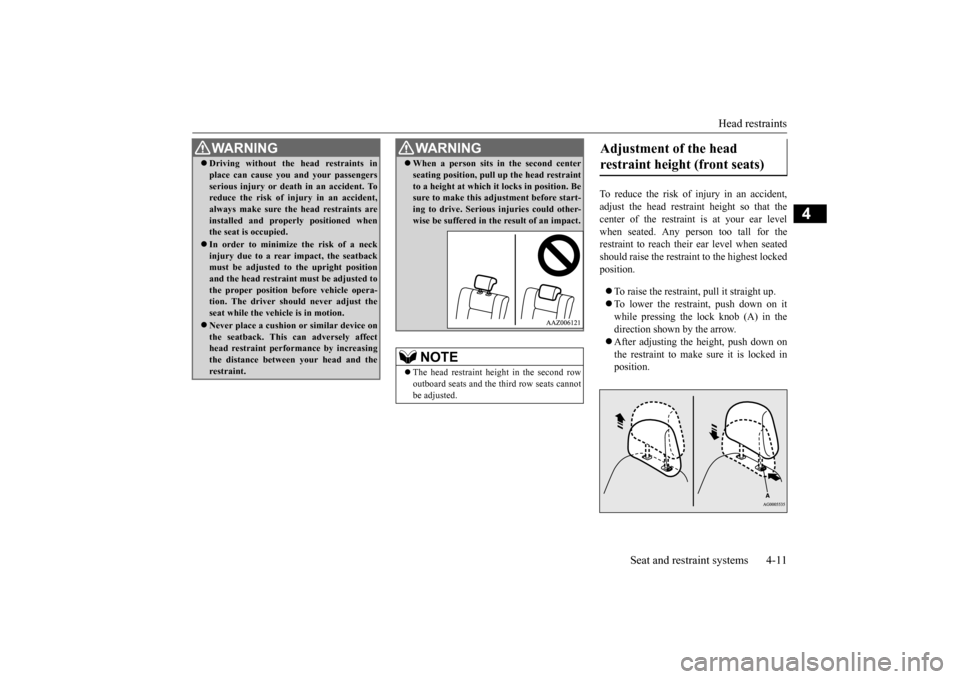
Head restraints
Seat and restraint systems 4-11
4
To reduce the risk of injury in an accident, adjust the head restraint height so that thecenter of the restraint is at your ear level when seated. Any person too tall for the restraint to reach their ear level when seatedshould raise the restrain
t to the highest locked
position. To raise the restraint,
pull it straight up.
To lower the restraint, push down on it while pressing the lock knob (A) in the direction shown by the arrow. After adjusting the height, push down on the restraint to make sure it is locked in position.
WA R N I N G Driving without the head restraints in place can cause you and your passengersserious injury or deat
h in an accident. To
reduce the risk of injury in an accident, always make sure the head restraints are installed and properly positioned whenthe seat is occupied. In order to minimize
the risk of a neck
injury due to a rear impact, the seatback must be adjusted to the upright position and the head restraint must be adjusted tothe proper position
before vehicle opera-
tion. The driver shou
ld never adjust the
seat while the vehicle is in motion. Never place a cushion
or similar device on
the seatback. This can adversely affecthead restraint performance by increasing the distance between your head and the restraint.
When a person sits in the second center seating position, pull
up the head restraint
to a height at which it locks in position. Besure to make this adjustment before start- ing to drive. Serious injuries could other- wise be suffered in the result of an impact.NOTE
The head restraint height in the second row outboard seats and the third row seats cannot be adjusted.WA R N I N G
Adjustment of the head restraint height (front seats)
BK0223400US.book 11 ページ 2015年2月13日 金曜日 午後12時15分
Page 38 of 464
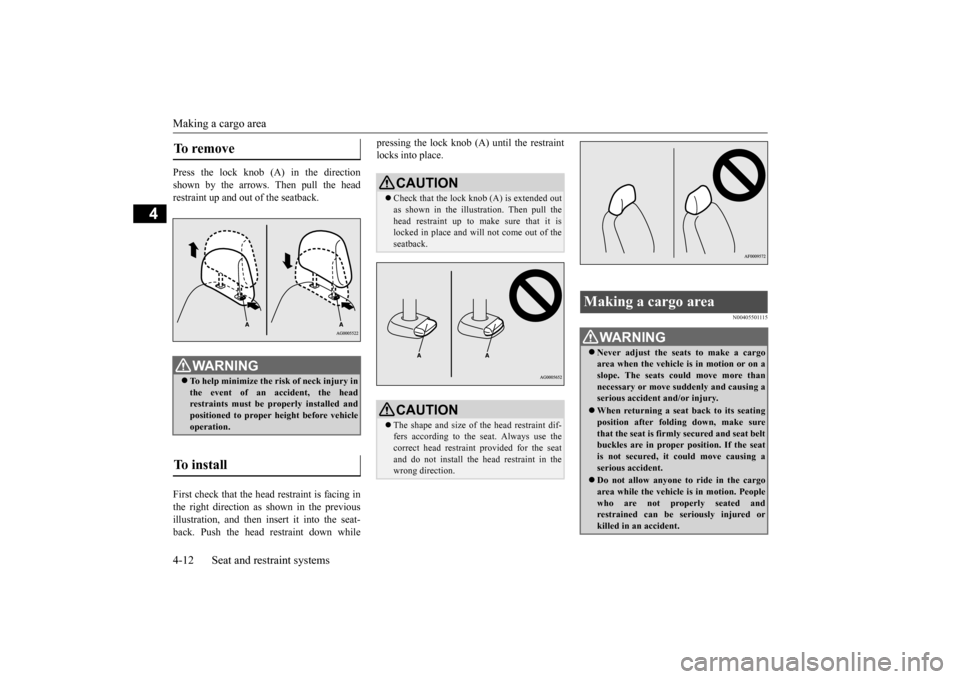
Making a cargo area 4-12 Seat and restraint systems
4
Press the lock knob (A) in the direction shown by the arrows. Then pull the head restraint up and out of the seatback. First check that the head restraint is facing in the right direction as
shown in the previous
illustration, and then insert it into the seat- back. Push the head restraint down while
pressing the lock knob (A) until the restraint locks into place.
N00405501115
To remove
WA R N I N G To help minimize the risk of neck injury in the event of an
accident, the head
restraints must be properly installed and positioned to proper height before vehicle operation.
To install
CAUTION Check that the lock knob (A) is extended out as shown in the illustration. Then pull the head restraint up to make sure that it is locked in place and will
not come out of the
seatback.CAUTION The shape and size of the head restraint dif- fers according to the seat. Always use the correct head restrain
t provided for the seat
and do not install the he
ad restraint in the
wrong direction.
Making a cargo area
WA R N I N G Never adjust the seats to make a cargo area when the vehicle is
in motion or on a
slope. The seats could move more thannecessary or move suddenly and causing a serious accident
and/or injury.
When returning a seat back to its seating position after folding down, make sure that the seat is firmly secured and seat beltbuckles are in proper position. If the seat is not secured, it could move causing a serious accident. Do not allow anyone to ride in the cargo area while the vehicle
is in motion. People
who are not properly seated and restrained can be seriously injured or killed in an accident.
BK0223400US.book 12 ページ 2015年2月13日 金曜日 午後12時15分
Page 39 of 464
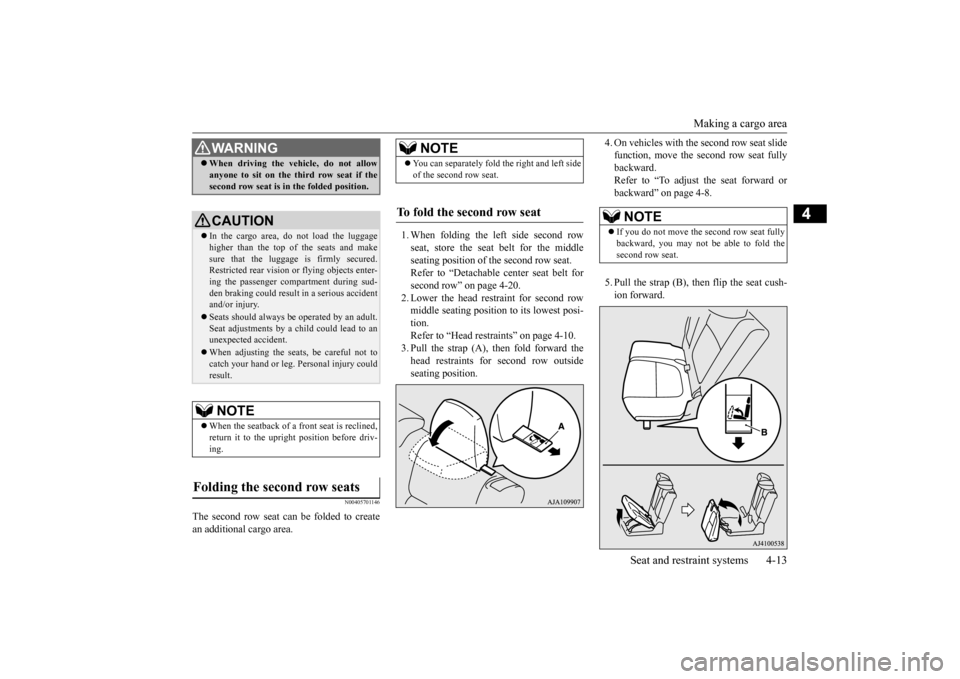
Making a cargo area
Seat and restraint systems 4-13
4
N00405701146
The second row seat can be folded to create an additional cargo area.
1. When folding the left side second row seat, store the seat belt for the middle seating position of the second row seat.Refer to “Detachable center seat belt for second row” on page 4-20. 2. Lower the head restraint for second rowmiddle seating position
to its lowest posi-
tion. Refer to “Head restraints” on page 4-10.3. Pull the strap (A), then fold forward the head restraints for second row outside seating position.
4. On vehicles with the second row seat slide function, move the se
cond row seat fully
backward. Refer to “To adjust the seat forward or backward” on page 4-8. 5. Pull the strap (B), then flip the seat cush- ion forward.
When driving the vehicle, do not allow anyone to sit on the third row seat if thesecond row seat is in the folded position.CAUTION In the cargo area, do not load the luggage higher than the top of the seats and makesure that the luggage is firmly secured. Restricted rear vision
or flying objects enter-
ing the passenger compartment during sud-den braking could result
in a serious accident
and/or injury. Seats should always be
operated by an adult.
Seat adjustments by a child could lead to an unexpected
accident.
When adjusting the seats, be careful not to catch your hand or leg.
Personal injury could
result.NOTE
When the seatback of a front seat is reclined, return it to the upright position before driv- ing.
Folding the second row seats
WA R N I N G
NOTE
You can separately fold
the right and left side
of the second row seat.
To fold the second row seat
NOTE
If you do not move the second row seat fully backward, you may not be able to fold the second row seat.
BK0223400US.book 13 ページ 2015年2月13日 金曜日 午後12時15分
Page 41 of 464
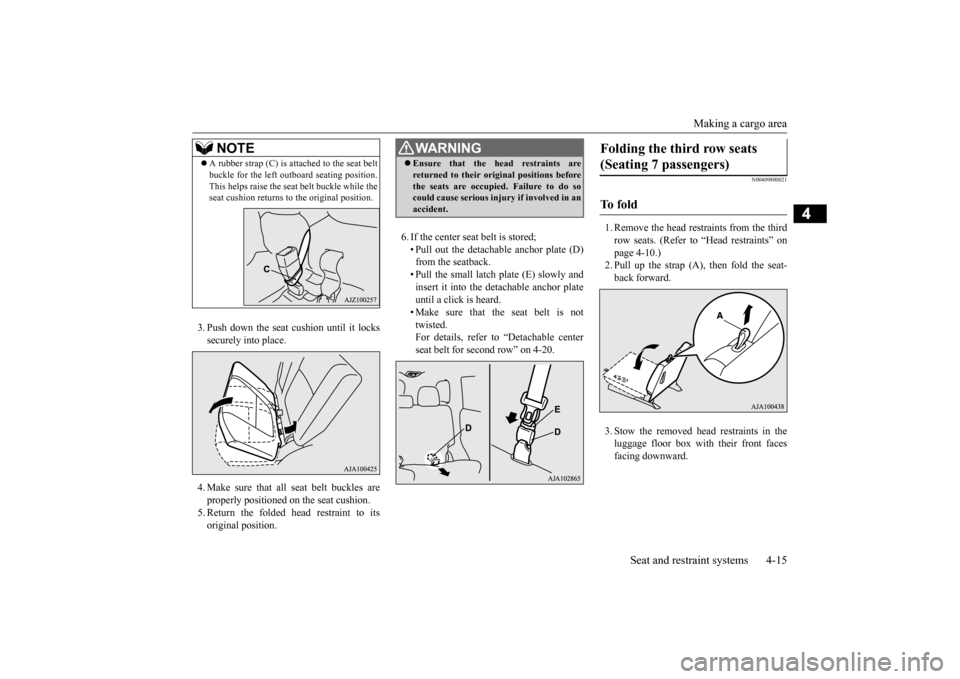
Making a cargo area
Seat and restraint systems 4-15
4
3. Push down the seat cushion until it locks securely into place. 4. Make sure that all
seat belt buckles are
properly positioned on the seat cushion. 5. Return the folded head restraint to itsoriginal position.
6. If the center seat belt is stored; • Pull out the detachable anchor plate (D) from the seatback.• Pull the small latch plate (E) slowly and insert it into the detachable anchor plate until a click is heard.• Make sure that the seat belt is not twisted. For details, refer to “Detachable centerseat belt for second row” on 4-20.
N00409800021
1. Remove the head restraints from the third row seats. (Refer to
“Head restraints” on
page 4-10.)2. Pull up the strap (A), then fold the seat- back forward. 3. Stow the removed head restraints in the luggage floor box with their front faces facing downward.
NOTE
A rubber strap (C) is attached to the seat belt buckle for the left out
board seating position.
This helps raise the seat
belt buckle while the
seat cushion returns to the original position.
WA R N I N G Ensure that the head restraints are returned to their original positions beforethe seats are occupied. Failure to do socould cause serious inju
ry if involved in an
accident.
Folding the third row seats (Seating 7 passengers) To f o l d
BK0223400US.book 15 ページ 2015年2月13日 金曜日 午後12時15分
Page 42 of 464

Making a flat seat 4-16 Seat and restraint systems
4
1. Pull the strap (A), then raise the seatback until it locks securely into place.Push lightly on the seatback to confirm that it has actually been secured. 2. Install the head restraints.
N00404801166
The entire interior of the vehicle may be used for sleeping accomm
odations by removing
the head restraints and fully reclining all theseats when the vehicle is stopped.
1. Remove the head re
straints from the front
seats and raise the arm rest on the secondrow seats. For vehicles with a cargo area cover, remove the cover.(Refer to “Head restraints” on page 4-10, “Arm rest” on page 4-9 and “Cargo area cover” on page 5-233.) 2. Slide the second row seats back as far as possible (vehicles with second row seat slide function).(Refer to “To adjust the seat forward or backward” on page 4-8.)
To r e t u r n
Making a flat seat
WA R N I N G Never drive with passengers or cargo on the flat seat. This is extremely dangerousand can cause severe or fatal injury or death in an accident
or if heavy braking is
required.CAUTION Adjust the seats only
when the vehicle is
stopped in a safe place. Seat should be adjusted only by adults to avoid accidents. When sliding the seat
s, be careful not to
catch your hand or leg. Do not walk around on t
op of the seats after
they have been laid fl
at because the footing
is uneven. It is safe
st to move about on your
hands and knees. To ensure the seats are locked securely, attempt to move them back and forth. Do not jump on or drop heavy objects on the seatbacks.
To raise the seatback of the front seat, firmly place your hand on th
e seatback, pull the
seatback lock knob up,
and raise the seatback
slowly. (Refer to “To adjust the seatback” on page 4-6.) Do not let ch
ildren adjust the seat-
back.CAUTION
BK0223400US.book 16 ページ 2015年2月13日 金曜日 午後12時15分
Page 43 of 464
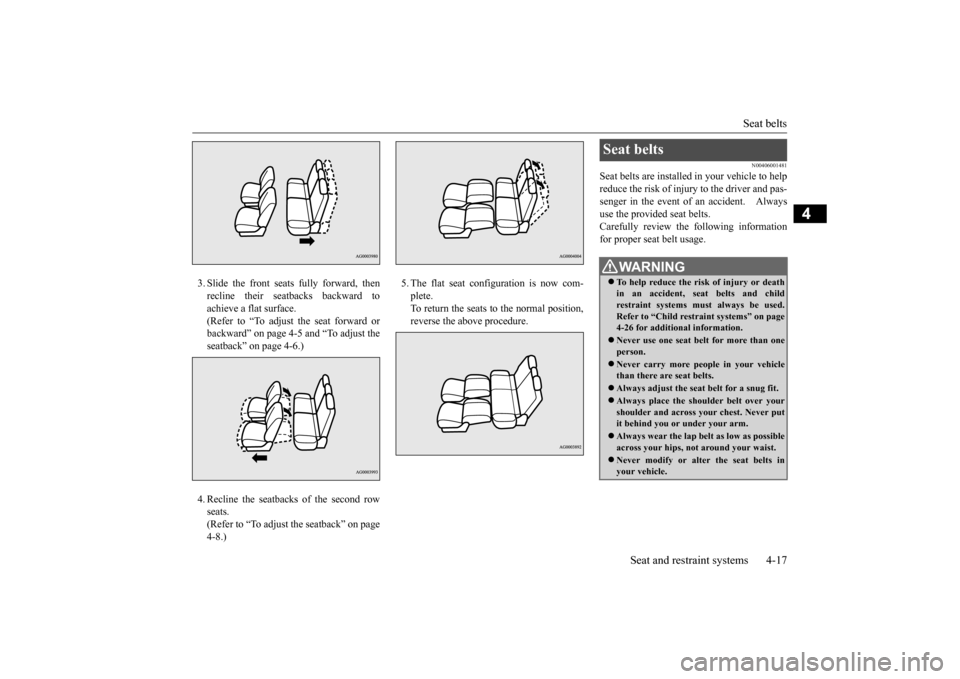
Seat belts
Seat and restraint systems 4-17
4
3. Slide the front seats fully forward, then recline their seatbacks backward toachieve a flat surface. (Refer to “To adjust the seat forward or backward” on page 4-5 and “To adjust theseatback” on page 4-6.) 4. Recline the seatbacks of the second row seats.(Refer to “To adjust the seatback” on page 4-8.)
5. The flat seat configuration is now com- plete.To return the seats to the normal position, reverse the above procedure.
N00406001481
Seat belts are installed in your vehicle to helpreduce the risk of injury to the driver and pas- senger in the event of an accident. Alwaysuse the provided seat belts. Carefully review the
following information
for proper seat belt usage.Seat belts
WA R N I N G To help reduce the risk of injury or death in an accident, se
at belts and child
restraint systems must always be used. Refer to “Child restra
int systems” on page
4-26 for additional information. Never use one seat belt for more than one person. Never carry more peop
le in your vehicle
than there are seat belts. Always adjust the seat
belt for a snug fit.
Always place the shou
lder belt over your
shoulder and across you
r chest. Never put
it behind you or
under your arm.
Always wear the lap belt as low as possible across your hips, not around your waist. Never modify or alter the seat belts in your vehicle.
BK0223400US.book 17 ページ 2015年2月13日 金曜日 午後12時15分
Page 44 of 464

Seat belts 4-18 Seat and restraint systems
4
N00406201467
All seats are equipped with a seat belt which uses one combined lap-and-shoulder belt with an emergency locking retractor. This system is designed to provide both com- fort and safety. It perm
its full extension and
automatic retraction of the belts during nor- mal vehicle operation.
A sensing device
inside the belt retractor is designed to lock the retractor in the event of a sudden change inthe vehicle’s motion. 1. Occupants should always
sit back in their
seats with their backs against the upright seatback. To reduce
the risk of serious
injury or death during deployment of the airbag, adjust the driver’s seat as far back as possible while maintaining a positionthat still enables you to fully apply the pedals, easily contro
l the steering wheel,
and safely operate the vehicle. The frontpassenger seat should also be moved as far back as possible.
Refer to “Supple-
mental Restraint Syst
em (SRS) - airbag”
on page 4-33. Also refer to “To adjust the seat forward or backward” on page 4-5.
To reduce the risk to the driver of serious injury or death duri
ng deployment of the
driver’s airbag, always
properly wear the
seat belt and adjust th
e driver’s seat as far
back as possible while maintaining a posi- tion that still enables
you to fully apply the
pedals, easily control the steering wheel, and safely operate the vehicle. To reduce the risk to a front seat passen- ger of serious injury or death from a deploying airbag, make sure the passengeralways wears the seat belt properly, remains seated all the way back and upright in their seat,
and moves the seat as
far back as possible. Refer to “Supplemen- tal Restraint System (SRS) - airbag” on page 4-33 for additional information. Never hold an infant
or child in your arms
or on your lap when ri
ding in this vehicle
even when you are we
aring your seat belt.
Never place any part of the seat belt you are wearing around an infant or child.Failure to follow these simple instructions creates a risk of serious injury or death to your child in the even
t of an accident or
sudden stop.WA R N I N G
Children 12 years ol
d and under should
always ride in the re
ar seat and be prop-
erly restrained. This reduces their risk ofserious injury or de
ath in an accident,
especially due to a deploying front passen- ger’s airbag. Refer to
“Child restraint sys-
tems” on page 4-26 for additional information. Any child who is t
oo small to properly
wear a seat belt must be properly restrained in an
appropriate child
restraint system. Infants MUST be placed in a rear-facing child safety seat and
positioned in the rear
seat. In the event of an ac
cident, all seat belt
assemblies, including retractors and attachment hardware, should be inspectedby an authorized Mitsubishi Motors dealer to determine whether replacement is necessary.
Seat belt instructions
WA R N I N G
NOTE
For instructions on inst
alling a child restraint
system using a seat belt
, refer to “Installing a
child restraint system using the seat belt” on page 4-31.
BK0223400US.book 18 ページ 2015年2月13日 金曜日 午後12時15分
Page 50 of 464

Seat belt use during pregnancy 4-24 Seat and restraint systems
4
Put the seat belt webbing in the back slot (A) on the clip and insert the metal plate of thelatch plate into the front slot (B) as shown in the illustration.
N00406701202
If your seat belt is
not long enough, even
when fully extended,
a seat belt extender
must be obtained. Th
e extender may be used
for either of the front seats.
N00406800134
Seat belts work for
everyone, including preg-
nant women. Like al
l occupants, pregnant
women are more likely to be seriously injuredor killed in an accide
nt if they do not wear
seat belts.
N00417701710
The driver’s and front passenger’s seats each have a seat belt equippe
d with a pre-tensioner
system and force limiter system.
Seat belt extender
WA R N I N G The extender should only be used if the existing belt is not long enough. Anyone who can use the standard seat belt shouldnot use an extender.
Unnecessary use of an
extender can adversel
y affect seat belt
performance in an accident. When not required, the extender must be removed and stowed.
Seat belt use during preg- nancy
WA R N I N G To reduce the risk of serious injury or death to pregnant women and unborn children in an accident, pregnant womenshould always wear
a seat belt. The lap
portion of the seat belt should be worn snug and low across the hips and belowthe rounding. Consult your doctor if you have any additional qu
estions or concerns.
Seat belt pre-tensioner and force limiter systems
BK0223400US.book 24 ページ 2015年2月13日 金曜日 午後12時15分